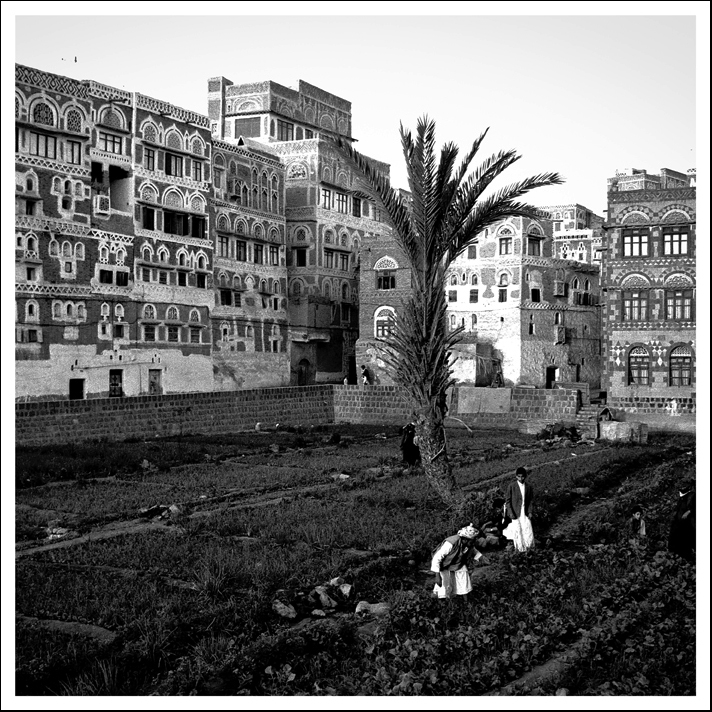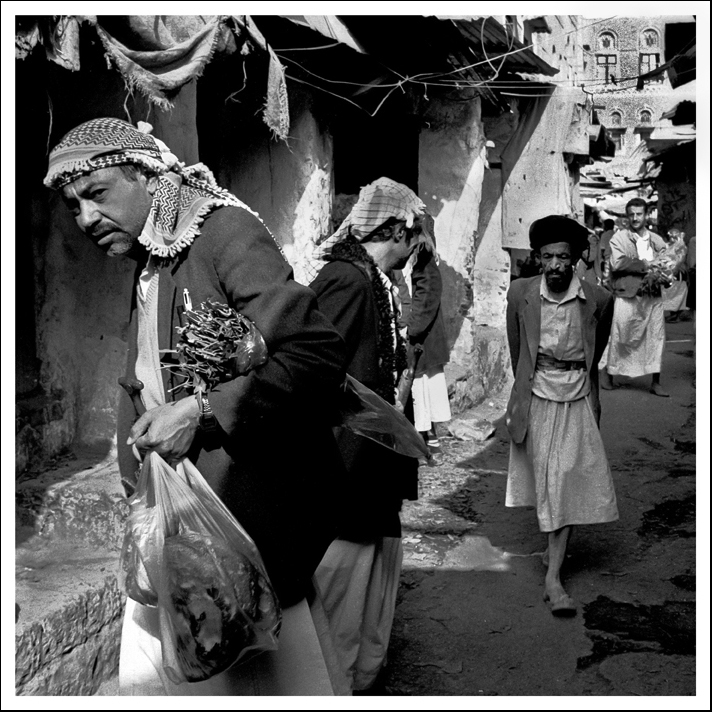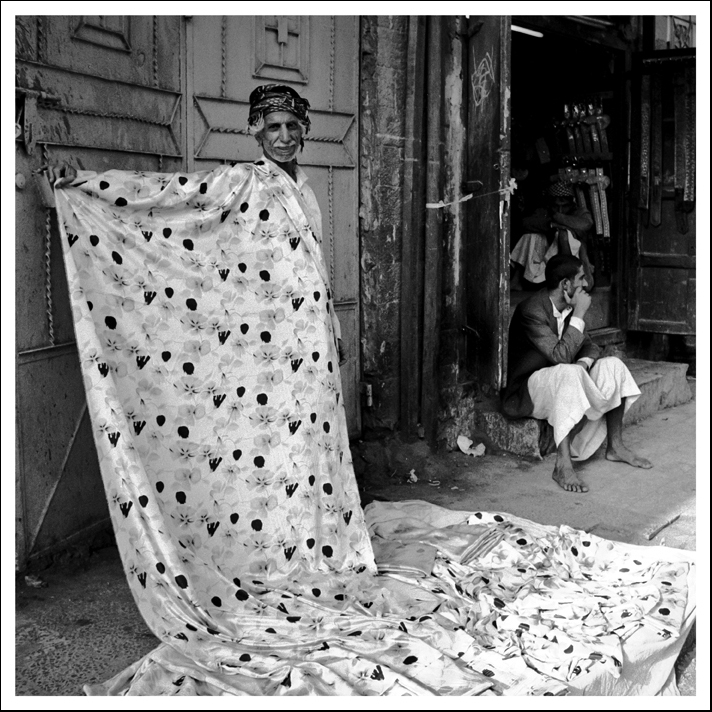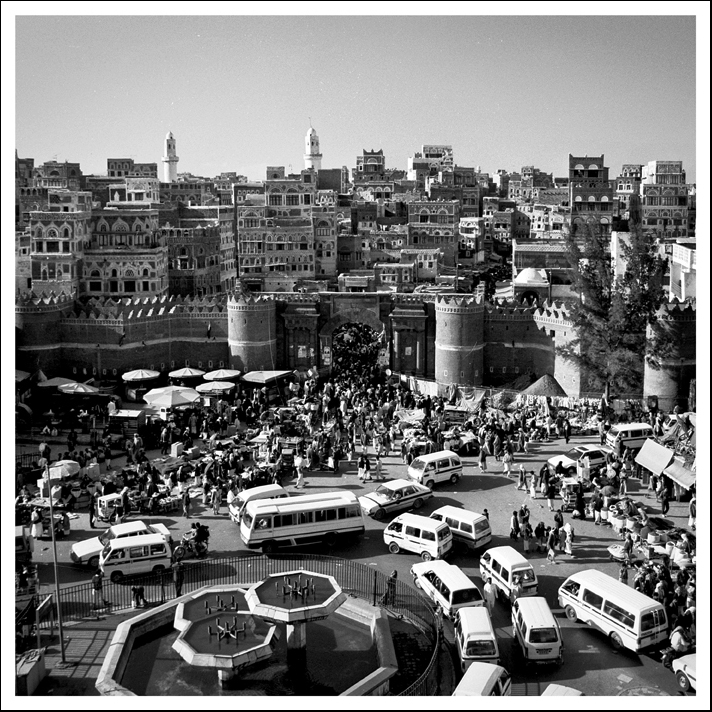Sana'a, formerly the capital of North Yemen since 1990 is the capital of Yemen reunified. Located at the center of a vast plateau, is walled with typical multi-storey buildings Yemenis; commercial, cultural and economic center of the country. It is divided by internal walls in three districts (Arabic, turkish and jew).
According to tradition, the foundation of the city dates back to biblical times; was founded by Sem, the eldest son of Noah and progenitor populations semite, who after abandoning his country he found first the Rub' al-Khali, the "Empty Quarter"- terrible sandy desert - and, subsequently, a land of high mountains and fertile valleys and decided to found a city: Sana'a.

The palaces of Sana'a

Sana'a, gardens in the city

Sana'a, Jambiya shop

The jambiya is the archetypal form of dagger of the Arabian Peninsula from which developed several similar arms manesche type knife in the lands then touched by the propagation of Islam. Weapon of practical use, for personal defense or during the duel, had and still has a very strong value as status symbols which denominator of male adulthood and as a vehicle for communication to the community of their own power and prestige within the tribe . As the Japanese katana, can only be removed in the event of proven necessity or for certain occasions and holidays (a dance of knives with use of jambiya is still an integral part of Yemeni marriage).

Sana'a, portrait

Sana'a, portrait

Sana'a Qat shop.
Qat is a plant native to the eastern regions of Africa (Ethiopia probably), but widespread in the Arabian peninsula. The leaves of this plant contain an alkaloid stimulant by the action, that causes states of excitement and euphoria, and that causes forms of dependence. In 1980 the World Health Organization has classified qat between drugs. Its cultivation and use as drugs are widespread in the territory of Yemen.
In populations where it is in use, the qat almost always plays a huge social significance.
The eating of the plant is in fact a social fact, can be a unique opportunity to relationship "on par" in some societies otherwise internally is clearly separated by sex for both census. For this reason, in some Arab countries, although formally prohibited, the substance is tolerated, or even knowingly used, because attenuates social contrasts.
In populations where it is in use, the qat almost always plays a huge social significance.
The eating of the plant is in fact a social fact, can be a unique opportunity to relationship "on par" in some societies otherwise internally is clearly separated by sex for both census. For this reason, in some Arab countries, although formally prohibited, the substance is tolerated, or even knowingly used, because attenuates social contrasts.
You frequently assist in the formation of public "spontaneous groups" of masticatory, chatting animatedly, for example, to the bus stop.

Sana'a, strolling seller

Sana'a, Suq Al Milh, spices market

Sana'a, Suq Al Milh, spices market

Sana'a, the alleys of the city

Dar Al Hajar. In the valley of Wadi Dhahr stands the Palace of the Rock (Dar al-Hajar), one of the most photographed sites in Yemen, which has become a kind of symbol of the whole country for his bold position. The palace is the architectural excellence and shows how people transform complications of the nature in monuments. All this is clear to anyone visiting the Wadi Dhahr; looking out from a mountain you can see a huge palace built on top of a mountain, in the heart of the valley which is surrounded by fruit trees. The fame of this valley dates back to the past, as indicated by the drawings found in the rocks of the valley, which led archaeologists to conclude that the valley was inhabited since prehistoric times.

Old City of Sana'a
Situated in a mountain valley at an altitude of 2,200 m, Sana’a has been inhabited for more than 2,500 years. In the 7th and 8th centuries the city became a major centre for the propagation of Islam. This religious and political heritage can be seen in the 103 mosques, 14 hammams and over 6,000 houses, all built before the 11th century. Sana’a’s many-storeyed tower-houses built of rammed earth add to the beauty of the site.

